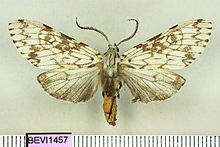Lepidozikania similis
In today's world, Lepidozikania similis has become a topic of great relevance and interest at a global level. From its origins to its impact on contemporary society, Lepidozikania similis has played a fundamental role in various aspects of daily life. Whether through its influence on popular culture, its contribution to technological advancement, or its significance in history, Lepidozikania similis has generated a vast field of study and research that continues to fascinate experts and hobbyists alike. In this article, we will explore the multiple facets of Lepidozikania similis, analyzing its importance and scope in different areas, to fully understand its significance in today's world.
| Lepidozikania similis | |
|---|---|

| |
| Scientific classification | |
| Domain: | Eukaryota |
| Kingdom: | Animalia |
| Phylum: | Arthropoda |
| Class: | Insecta |
| Order: | Lepidoptera |
| Superfamily: | Noctuoidea |
| Family: | Erebidae |
| Subfamily: | Arctiinae |
| Genus: | Lepidozikania |
| Species: | L. similis
|
| Binomial name | |
| Lepidozikania similis Travassos, 1949
| |
Lepidozikania similis is a moth of the family Erebidae first described by Travassos in 1949. It is found in Brazil.[1][2]
References
- ^ Savela, Markku. "Lepidozikania similis Travassos, 1949". Lepidoptera and Some Other Life Forms. Retrieved September 18, 2019.
- ^ "Taxonomy Browser: Lepidozikania similis". Barcode of Life Data System (BOLD). Retrieved September 18, 2019.
- Pitkin, Brian & Jenkins, Paul. "Search results Family: Arctiidae". Butterflies and Moths of the World. Natural History Museum, London.